Forty-five years ago, on May 18, 1980, the city of Gwangju witnessed a fierce resistance by citizens against the military junta led by Chun Doo-hwan—a desperate fight to preserve democracy. For the past 45 years, efforts to uncover the truth behind the May 18 Gwangju Democratization Movement and uphold its spirit have continued to resonate throughout South Korean society. Seoul National University (SNU), a campus where students continuously resisted dictatorship and demanded democracy, has remained committed to remembering and reflecting on the significance of the Gwangju Democratization Movement and the student movements of the 1980s. On this 45th anniversary of the Gwangju Democratization Movement, we examine the commitment of SNU members to democratization and the ways in which these pivotal events continue to be remembered.
Tracing Student Activism at the SNU Archives
The SNU Archives (hereafter Archives), located in Building 75 on the Gwanak Campus, holds a substantial collection of materials related to the May 18 Gwangju Democratization Movement. Speaking on the significance of SNU preserving records of an event that primarily unfolded in Gwangju, Archives Director Jeong Byeong-seol stated, "South Korea's democracy, as it stands today, has been forged through relentless efforts to achieve genuine democracy by resisting dictatorship and privilege. This path was paved with the profound self-sacrifice of many citizens, including numerous members of Seoul National University."
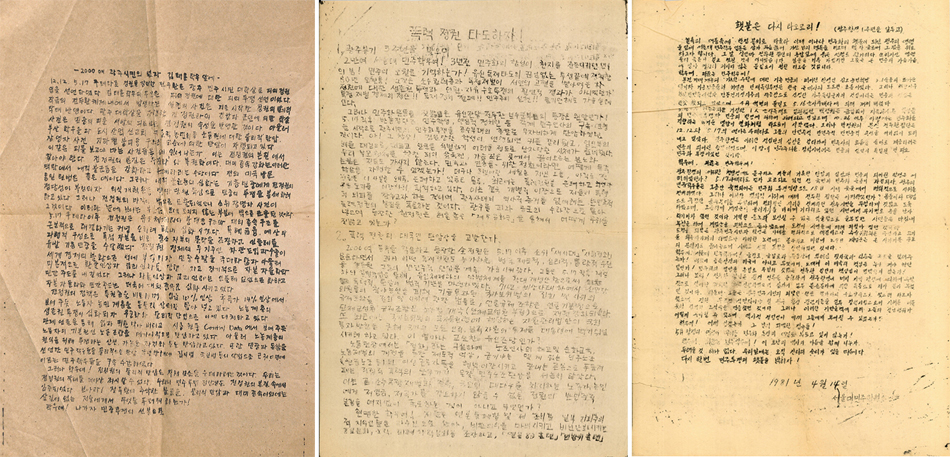
Posters commemorating the May 18 Gwangju Democratization Movement and honoring victims, including fellow student Kim Tae-hoon (Courtesy of the University Archives)
The stark reality of the period was tragically highlighted on May 27, 1981, the year following the Gwangju Democratization Movement. Kim Tae-hoon, a student from Gwangju, now remembered as a martyr, jumped to his death from the sixth floor of the university library during a demonstration demanding democratization at Acropolis Square. Before his fatal act, he shouted "Chun Doo-hwan, step down!" three times. Director Jeong Byeong-seol recalls the oppressive atmosphere of the time, noting that the truth of the Gwangju Democratization Movement could not be freely discussed due to strict government censorship. "The government labeled the citizens who participated in the Gwangju Democratization Movement as rioters," he testified, conveying the chilling climate of the era. Director Jeong added, "Despite these grim circumstances, the actions of students who created and distributed leaflets to raise awareness about the Gwangju Democratization Movement revealed their profound sorrow, anger, and fervent desire for democratization."
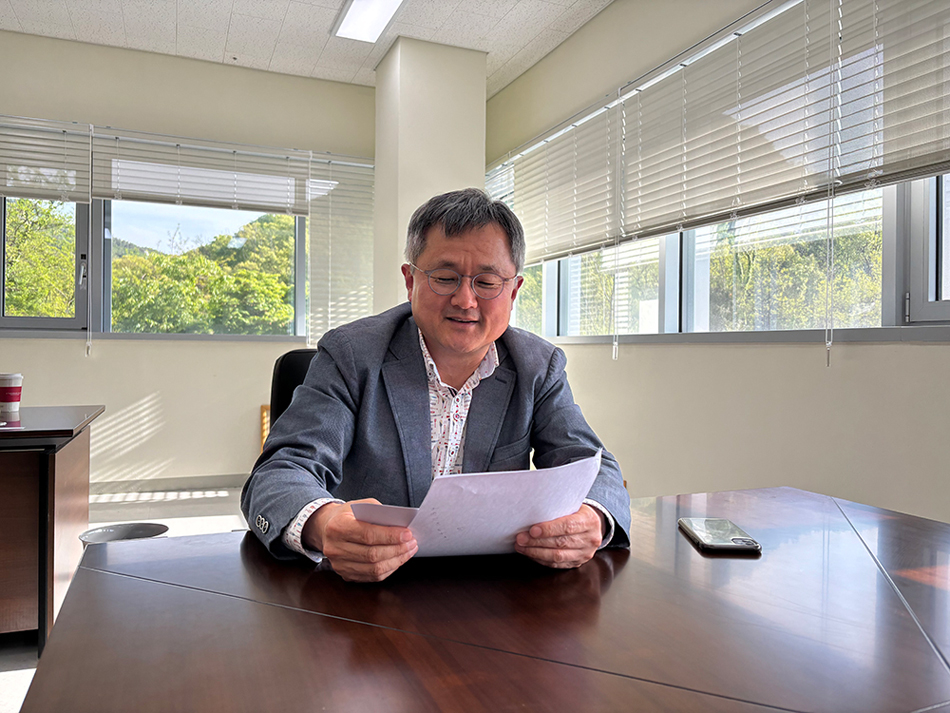
Director Jeong Byeong-seol of the SNU Archives speaks in an interview
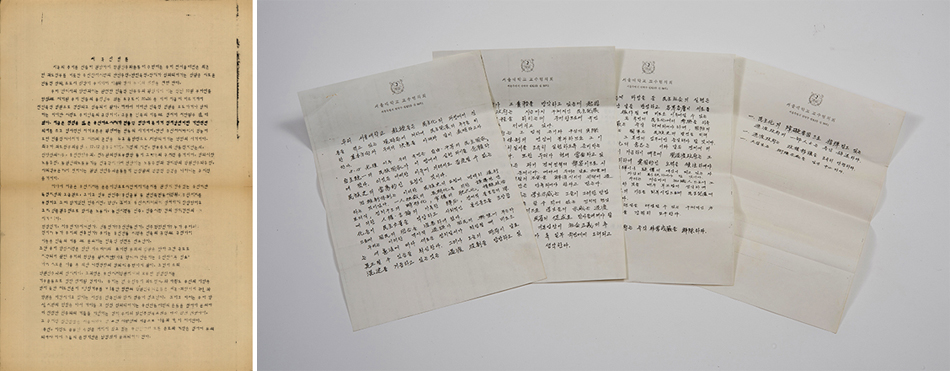
A draft of a political statement by SNU faculty (right) and a public declaration on the national situation (left). (Courtesy of the University Archives) The “SNU Faculty Statement on the National Crisis,” written in May 1980, was scheduled to be announced at a board meeting on May 19, but was never delivered due to the nationwide expansion of martial law and enforced university closures on May 17.
Director Jeong recalled the tragic day in 1986 when student Lee Dong-soo took his own life at the SNU Student Union Building. “Lee Dong-soo likely felt frustrated that so many people were unaware of the Gwangju Democratization Movement,” Jeong reflected. “He must have thrown himself in hopes of revealing the truth.” He recounted that the incident occurred on a day when the late Reverend Moon Ik-hwan had come to SNU for a lecture. A large crowd had gathered at the Acropolis, and suddenly, a blazing body fell from the Student Union Building. Jeong added, “There are very few photographs documenting moments when SNU students sacrificed themselves for democracy. But because Reverend Moon was visiting that day, many journalists, including photojournalists, were present. That’s why this moment remains one of the few captured and published.” Quoting Lee Dong-soo's words, “A person becomes a slave when they cannot say ‘No’,” Jeong emphasized the importance of remembering that the democracy we enjoy today was built through the sacrifices of many.
A Firsthand Look at 1980s Student Activism
Professor Park Tae-gyun of the Graduate School of International Studies, who entered Seoul National University in 1985 as a history major specializing in modern Korean history, shared his firsthand account of student activism during that era. “The government tried to suppress the student movement by forcibly drafting arrested students into the military,” he explained. Protests were often planned in secret and held without prior notice, as riot police were stationed on campus. Even after campus policies became more liberal, police would storm in during demonstrations and fire tear gas. “Tear gas canisters would be launched into student lounges,” he recalled. “And when students hid in professors’ offices, riot police would assault the professors or fire gas into classrooms in the middle of lectures.” Professor Park also remembered a 1986 incident at Beodeulgol, where protesting students were arrested on the spot. His recollections serve as a stark reminder of just how much Korean society has changed over the past four decades.
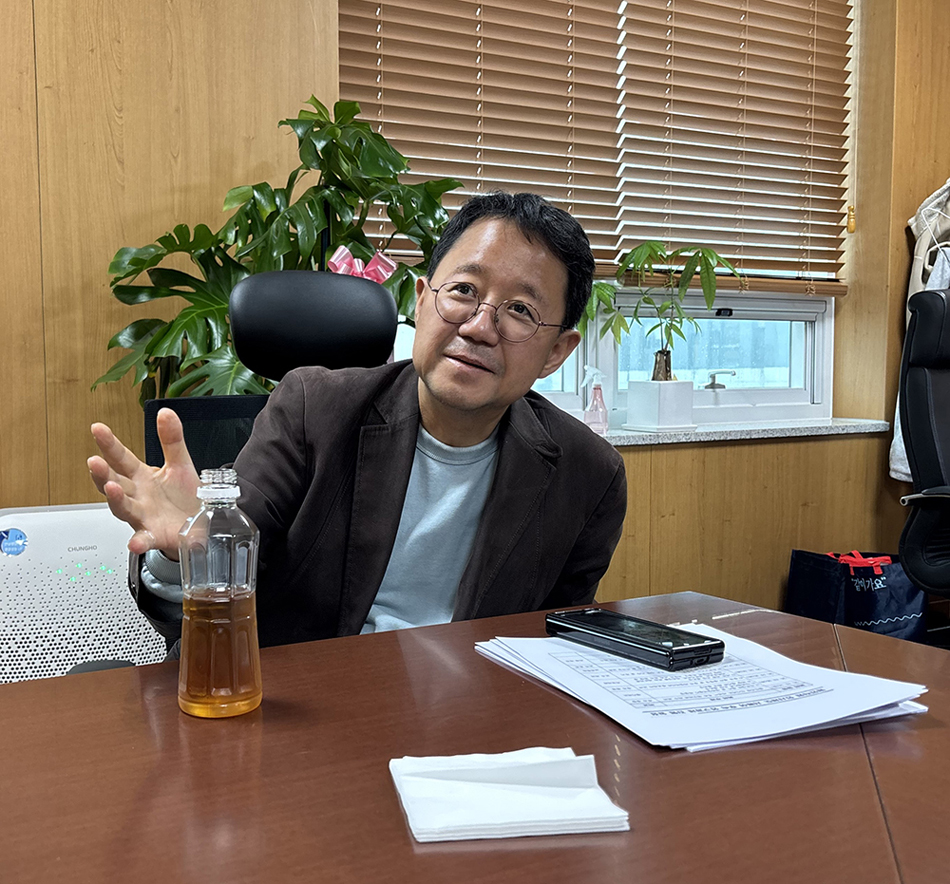
Professor Park Tae-gyun of the Graduate School of International Studies reflects on his time as a student activist.
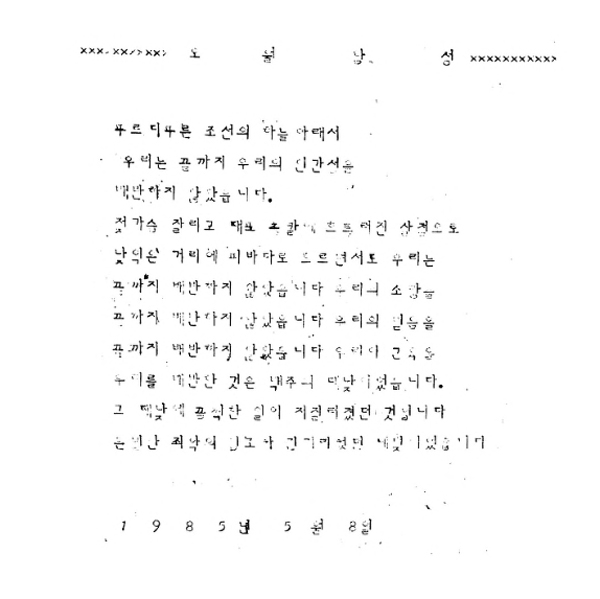
Cover of the first issue of May Voices, promoting awareness of the May 18 Uprising. (University Archives)
Professor Park Tae-gyun explained that the May 18 Gwangju Democratization Movement marked a turning point in Korea’s democratic history—an awakening in which citizens began to play a central role in the push for reform. Recalling how he first learned about the uprising, Park said: “We watched videotapes in the student union and department lounges—footage taken by NHK and German broadcasters showing what had happened in Gwangju.” These unofficially circulated videos gave students their first visual exposure to the brutal crackdown. “Since the government refused to reveal the truth, rumors spread that thousands had been killed. The shock among students was immense.” That outrage, Park explained, spurred many into action: “Once people learned the truth about May 18, a significant number of students became actively involved in the movement.” He also recalled how student activism often took the form of campus festivals. “Student councils would hold school festivals around the anniversaries of the April 19 Revolution and the May 18 Uprising,” he said. “Though framed as festivals, these events became large-scale protests. The biggest demonstrations often occurred around May 18.”

(From left) Posters on the April 19 Revolution, the fight against the Yushin Constitution, and a graduate student statement on the democratization struggle. (Courtesy of the University Archives)
Professor Park Tae-gyun, like Director Jeong Byeong-seol, was present at the scene when student Lee Dong-soo took his life for the cause of democracy. He also witnessed other moments when SNU students made the ultimate sacrifice during Korea’s democratization struggle. Park recalled that in the 1980s, student-led class boycotts commonly occurred around the time of the May 18 Gwangju Uprising. In 1986, when he was a sophomore, students collectively refused to participate in the government-mandated "military training camp," which involved spending a week near the DMZ. Nearly 200 students protested at Sillim Intersection. On that day, two seniors—Lee Jae-ho from the Department of Political Science and Kim Se-jin from Microbiology—self-immolated in protest. Professor Park, who witnessed the act firsthand, was later detained by the police. “The trauma from that day still lingers,” he said. “I would see the fallen students in my dreams.” His account reveals the profound emotional toll and human cost of student activism during that turbulent era.
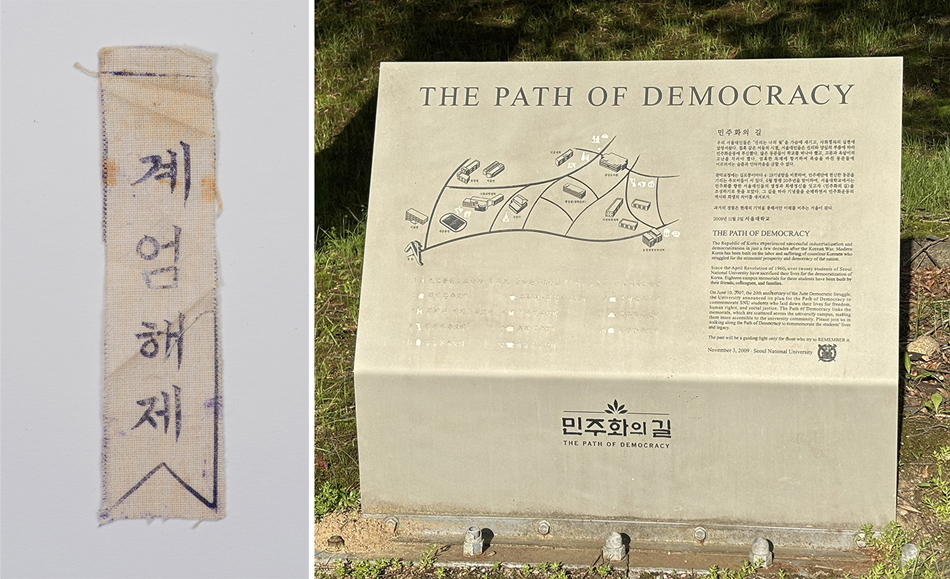
"Lift Martial Law" ribbon (1980s) (University Archives) and “Path to Democratization” sign on campus.
Despite government repression, the efforts of SNU members to achieve democratization never ceased. From the April 19 Revolution in 1960 to the June Democratic Uprising in 1987, student protests unfolded simultaneously across the nation. To honor the 19 SNU students who lost their lives in the democratization movement, memorials have been installed throughout the campus. In 2007, commemorating the 20th anniversary of the June Uprising, SNU launched the “Path to Democratization Committee,” which spent two years connecting scattered memorials into a single route with plaques and signposts. The 1.2-kilometer Path to Democratization was completed in November 2009, stretching from the April 19 Memorial Park through the Colleges of Social Sciences, Natural Sciences, Engineering, and Agriculture and Life Sciences.
Today, Korea’s democracy stands as the product of a long history of resistance and sacrifice. Professor Park Tae-gyun remarked, “I hope today’s students understand both what must never be done and what ought to be done—and that they appreciate the world their predecessors helped create.” Just as he emphasized, SNU students continue to uphold the spirit of the democratization movement and carry its legacy into the future.
Written by Euijoon Gwon, SNU Student Reporter(gwoneuijoon@snu.ac.kr)
Translated by Siyun Lee (Department of Applied Biology and Chemistry)

